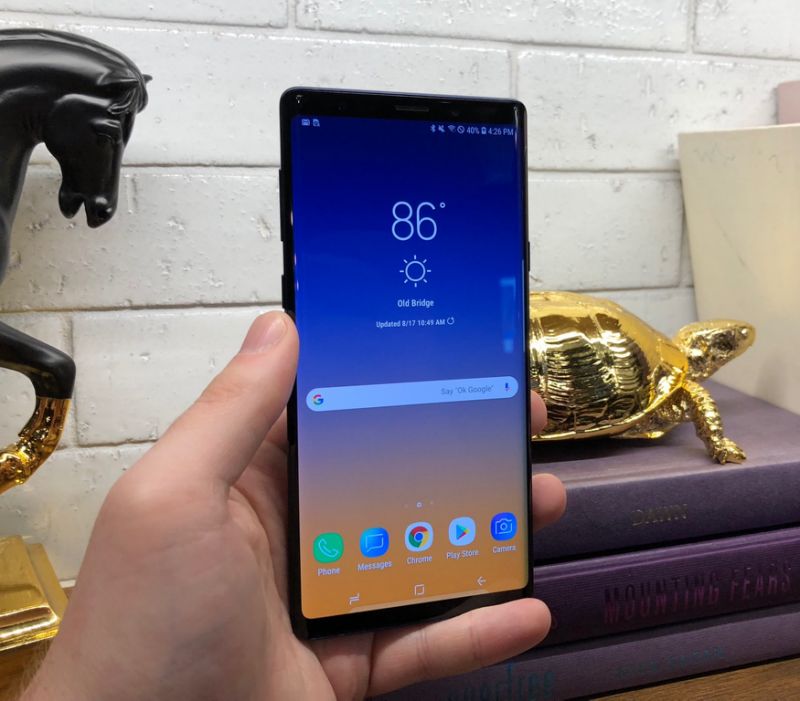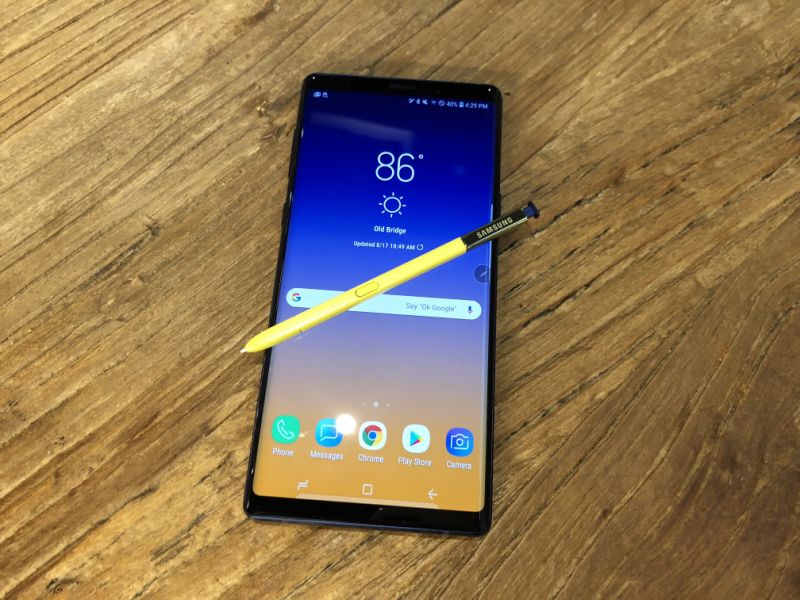Samsung’s Galaxy Note 9 is here, and it’s exactly what you’d expect. It’s big, bold and exemplifies everything that makes the tech giant’s smartphones some of the best on the market. It’s also, like the company’s recent handsets, not much of a departure from its predecessor.
That’s not a strike against it, by the way. The Note 8 was a fantastic big-screen smartphone, and the 9 follows in that same tradition. Throw in a nifty new AI-powered camera feature that automatically tunes the shooter to capture the most vibrant image, and a larger battery, and you’ve got one heck of a handset.
Of course, that’s if you have the $1,000 to cover the cost of the Note.
The more things change …
The Android-powered Note 9 looks almost exactly like the Note 8, which costs $749 unlocked. So if you were hoping for a radical redesign, you’re out of luck. The 9 looks like a carbon copy of the 8. There are some subtle differences — the Note 9 is a hair larger, though you’d need a magnifying glass to notice. Samsung used that extra real estate to increase the size of the Note’s display from 6.3 inches to 6.4. The change is likely a way for Samsung to better differentiate the Note from its Galaxy S Plus handsets.
Last year, the S9 Plus, $839 unlocked, offered a 6.2-inch display. Meanwhile, the Note 8, which is supposed to be the company’s big-screen beast, had a 6.3-inch panel — making it silly to opt for the pricier Note 8 since it’s not much bigger. Unless you’re a huge fan of the Note’s stylus.


Around back, the Note 9 has a dual-lens camera and and a fingerprint reader that’s below the camera rather than next to it like on the Note 8. That should make it easier to locate the reader and keep you from getting your greasy paws all over the camera.
The one appreciable difference between the Note 9 and older Note 8 is that the 9 now comes in two vibrant colors, a deep blue and purple lavender. What’s more, the Blue Note 9 features a flashy yellow S Pen stylus that adds a bit more character to the phone.
Display and S Pen
Samsung’s Super AMOLED displays are always among the best on the market, and that’s not different with the Note 9’s. This 6.4-inch colossus — seriously, how much bigger will these things get? — makes everything you see on it look downright gorgeous. It’s saying something when, at this point in the game, there’s little else Samsung can do to improve on its displays.
Compared to Apple’s (AAPL) iPhone X, the other big-name $1,000 handset out there, the Note 9 offers fuller, more vibrant colors. I used the trailer for “Thor: Ragnarok” to test the phones’ screens head-to-head and while the iPhone X’s looked crisp and beautiful, the Note 9’s tendency to exaggerate colors made the handset’s display appealing.


Outside of its monolithic screen, the Note 9’s second major selling point is Samsung’s S Pen stylus. Samsung’s been offering the S Pen since the Note line first debuted in 2011. And despite using every single iteration of the handset, I’ve never seen the point of using one with a smartphone.
But there are plenty of Samsung consumers who love the stylus. And for the Note 9 they’re getting some extra functionality out of the tiny gadget. The new S Pen Remote feature will let you launch and control certain apps without having to touch your phone.
The best use case Samsung showed was being able to get into group photos easily without having to race against the timer. So far, you can only control a select number of apps such as the music player, camera, YouTube, Chrome browser and Hancom Office Editor. However, that could change as the Note gets in the hands of more developers in the future.
I’m not entirely sold on the concept, though. I’m a fan of being able to launch and control the Camera app with the S Pen, but outside of that I don’t really see a purpose to the feature outside of serving as a gimmick for the Note.
Cameras
The Note 9’s dual-lens rear camera isn’t very different from the Galaxy S9 Plus’s. Don’t take that as a negative, though, as that phone had a truly impressive shooter. It does, however, feel like more proof that we’ve reached a kind of limit as to how much more smartphones can improve. Photos taken with the Note 9 are crisp and colorful, on par with what you’d get from the iPhone X.


Samsung’s big addition to the Note’s camera is its new AI feature called Scene Optimization, which uses artificial intelligence to automatically adjust the brightness, saturation, white balance and contrast to help you capture just the right shot. Samsung has preprogrammed the feature to recognize 20 scenes including pets, food, landscapes, flowers, buildings and more.


I used the setting to take a photo of a bouquet of roses, and it worked as advertised — enhancing the color of the petals and sharpening details. In a comparison shot taken with the iPhone X, one white rose looked too blown-out, making it more difficult to see. The Note 9, however, produced a clearer image overall.
That said, the Note 9’s shot was also darker, which seems to be the case when using Scene Optimization. I noticed a similar effect when taking a shot of a collection of plants. Without Scene Optimization on, images looked far more natural.
It’s worth noting that Scene Optimization takes a second to actually kick in, so it’s not going to be too useful when taking photos of quick-hit moments. It’s more for staged photos, like when you feel the overwhelming need to take a photo of your dinner. There were a few times when I would try to take a photo using Scene Optimization, but it simply wouldn’t kick in. However, such issues were few and far between.
Power and performance
There’s plenty of horsepower packed into the Note 9, which should come as no surprise to anyone who’s used a Note in the past. Samsung always makes its Notes the most powerful devices in its stable. The Note 9 follows that tradition using Qualcomm’s 845 8-core processor, 6GB of RAM and a whopping 128GB of storage.
Want to crank your Note 9 up to 11? Then you can opt for a version with a ridiculous 8GB of RAM and 512GB of storage. That’s probably pushing the boundaries of what’s necessary for a smartphone, but it’s still fun to have that kind of power available.


Needless to say, the Note 9 doesn’t suffer from any slowdown. I played games including “Pokemon Quest” and the Note kept powering along without a hiccup. To help manage the handset’s power, Samsung says it increased the size of the heat dissipator in the handset, which should keep performance stable for longer periods of time.
The Note 9 also packs a larger battery this time around. The 4,000 mAh unit gave me all-day performance and then some in my anecdotal testing. And while Samsung’s Note line has had issues with batteries in the past (hello, Note 7 fires), the company says this time around it is performing internal tests. It’s also letting the Underwriters Laboratory test them to ensure their safety.
Should you get it?
The Note 9, like the Note 8, is a fantastic big-screen smartphone that will please any Android fan. But its similarities to the Note 8 mean that if you already have last year’s handset, there’s no reason to upgrade. In fact, you’re likely better off waiting until Samsung debuts the S10 or Google’s next Pixel phones roll out later this year.
For everyone else, the Note 9 is as powerful, bold and impressive as ever, as long as you can get past that $1,000 price tag.
More from Dan:
Email Daniel Howley at dhowley@oath.com; follow him on Twitter at @DanielHowley. Follow Yahoo Finance on Facebook, Twitter, Instagram, and LinkedIn
Website: LINK

